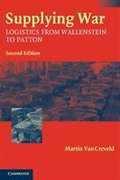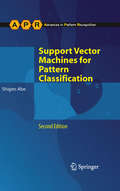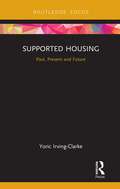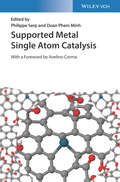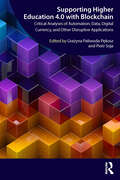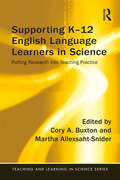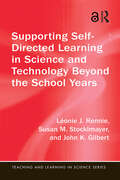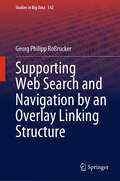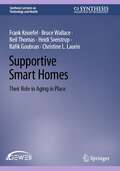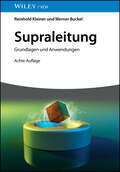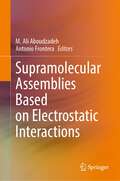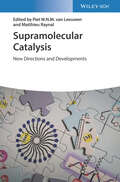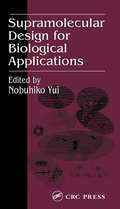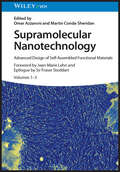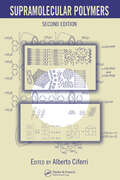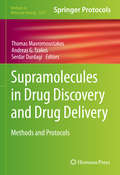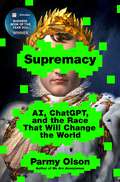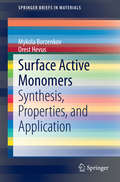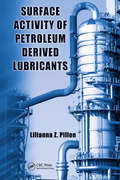- Table View
- List View
Supplying War: Logistics from Wallenstein to Patton
by Martin Van CreveldWhy did Napoleon succeed in 1805 but fail in 1812? Could the European half of World War II have been ended in 1944? These are only two of the many questions that form the subject-matter of this book. Drawing on a very wide range of sources, van Creveld examines the specifics of war: namely, those formidable problems of movement and supply, transportation and administration, so often mentioned - but rarely explored - by the vast majority of books on military history. In doing so he casts his net far and wide, from Gustavus Adolphus to Rommel, from Marlborough to Patton, subjecting the operations of each to a thorough analysis from an unusual point of view. In this edition with a new introduction, van Creveld revisits his now-classic text, and comments in a new afterword on the role of logistics in high-tech, modern warfare.
Supplying the Nuclear Arsenal: American Production Reactors, 1942-1992
by Rodney P. CarlisleOriginally published in 1996. Although the history of commercial-power nuclear reactors is well known, the story of the government reactors that produce weapons-grade plutonium and tritium has been shrouded in secrecy. Supplying the Nuclear Arsenal looks at the origin and development of these production reactors, Rodney Carlisle and Joan Zenzen describe a fifty-year government effort no less complex, expensive, and technologically demanding than the Polaris or Apollo programs—yet one about which most Americans know virtually nothing. Carlisle and Zenzen describe the evolution of the early reactors, the atomic weapons establishment that surrounded them, and the sometimes bitter struggles between business and political constituencies for their share of "nuclear pork." They show how, since the 1980s, aging production reactors have increased the risk of radioactive contamination of the atmosphere and water table. And they describe how the Department of Energy mounted a massive effort to find the right design for a new generation of reactors, only to abandon that effort with the end of the Cold War. Today, all American production reactors remain closed.Due to short half-life, the nation's supply of tritium, crucial to modern weapons, is rapidly dwindling. As countries like Iraq and North Korea threaten to join the nuclear club, the authors contend, the United States needs to revitalize tritium production capacity in order to maintain a viable nuclear deterrent. Meanwhile, as slowly decaying artifacts of the Cold War, the closed production reactors at Hanford, Washington, and Savannah River, South Carolina, loom ominously over the landscape.
Support Vector Machines for Pattern Classification
by Shigeo AbeA guide on the use of SVMs in pattern classification, including a rigorous performance comparison of classifiers and regressors. The book presents architectures for multiclass classification and function approximation problems, as well as evaluation criteria for classifiers and regressors. Features: Clarifies the characteristics of two-class SVMs; Discusses kernel methods for improving the generalization ability of neural networks and fuzzy systems; Contains ample illustrations and examples; Includes performance evaluation using publicly available data sets; Examines Mahalanobis kernels, empirical feature space, and the effect of model selection by cross-validation; Covers sparse SVMs, learning using privileged information, semi-supervised learning, multiple classifier systems, and multiple kernel learning; Explores incremental training based batch training and active-set training methods, and decomposition techniques for linear programming SVMs; Discusses variable selection for support vector regressors.
Support of Underground Excavations in Hard Rock
by E. Hoek P.K. Kaiser W.F. BawdenThe safe and economical construction of tunnels, mines, and other subterranean works depends on the correct choice of support systems to ensure that the excavations are stable. These support systems should be matched to the characterstics of the rock mass and the excavation techniques adopted. This expansive text explores the design of rockbolts, dowels, cable bolts and shortcrete for underground excavations in hard rock, and covers key topics including rock mass classification systems, and support design for overstressed rock.
Supported Housing: Past, Present and Future (Routledge Focus on Housing and Philosophy)
by Yoric Irving-ClarkeThis book covers the history of supported housing provision in the context of the broader political and theoretical considerations of the time in which the respective policies were being implemented. The book takes an historical perspective using path dependency as an analytical framework. Particular attention is paid to the critical junctures in the path of supported housing provision and how these limited and continue to limit the policy choices available. The book concludes with a look at the current state of supported housing policy with a view to making recommendations for how policy in this area could be carried forward. The hope is that readers of this book learn the lessons of previous policy initiatives in this area and, by looking at the philosophical underpinning for supported housing can make recommendations for how it can be funded and provided in the future. This book provides a valuable resource for scholars and practitioners seeking to both provide and influence policy in this area. It is also a useful source for students studying housing and urban policy.
Supported Layered Double Hydroxides as CO2 Adsorbents for Sorption-enhanced H2 Production
by Diana Iruretagoyena FerrerThis thesis presents a combination of material synthesis and characterization with process modeling. In it, the CO2 adsorption properties of hydrotalcites are enhanced through the production of novel supported hybrids (carbon nanotubes and graphene oxide) and the promotion with alkali metals. Hydrogen is regarded as a sustainable energy carrier, since the end users produce no carbon emissions. However, given that most of the hydrogen produced worldwide comes from fossil fuels, its potential as a carbon-free alternative depends on the ability to capture the carbon dioxide released during manufacture. Sorption-enhanced hydrogen production, in which CO2 is removed as it is formed, can make a major contribution to achieving this. The challenge is to find solid adsorbents with sufficient CO2 capacity that can work in the right temperature window over repeated adsorption-desorption cycles. The book presents a highly detailed characterization of the materials, together with an accurate measurement of their adsorption properties under dry conditions and in the presence of steam. It demonstrates that even small quantities of graphene oxide provide superior thermal stability to hydrotalcites due to their compatible layered structure, making them well suited as volume-efficient adsorbents for CO2. Lastly, it identifies suitable catalysts for the overall sorption-enhanced water gas shift process.
Supported Metal Single Atom Catalysis
by Philippe Serp Doan Pham Minh>Supported Metal Single Atom Catalysis Covers all key aspects of supported metal single atom catalysts, an invaluable resource for academic researchers and industry professionals alike Single atom catalysis is one of the most innovative and dynamic research areas in catalysis science. Supported metal catalysts are used extensively across the chemical industry, ranging from fine and bulk chemical production to petrochemicals. Single atom catalysts (SACs) combine the advantages of both homogeneous and heterogeneous catalysts such as catalyst stability, activity, and high dispersion of the active phase. Supported Metal Single Atom Catalysis provides an authoritative and up-to-date overview of the emerging field, covering the synthesis, preparation, characterization, modeling, and applications of SACs. This comprehensive volume introduces the basic principles of single atom catalysis, describes metal oxide and carbon support materials for SAC preparation, presents characterization techniques and theoretical calculations, and discusses SACs in areas including selective hydrogenation, oxidation reactions, activation of small molecules, C-C bond formation, and biomedical applications. Highlights the activity, selectivity, and stability advantages of supported metal SACs compared to other heterogeneous catalysts Covers applications of SACs in thermal catalysis, electrocatalysis, and photocatalysis Includes chapters on single atom alloys and supported double and triple metal atom catalysts Discusses the prospects, challenges, and potential industrial applications of SACs Supported Metal Single Atom Catalysis is an indispensable reference for all those working in the fields of catalysis, solid-state chemistry, materials science, and spectroscopy, including catalytic chemists, organic chemists, electrochemists, theoretical chemists, and industrial chemists.
Supporting Higher Education 4.0 with Blockchain: Critical Analyses of Automation, Data, Digital Currency, and Other Disruptive Applications
by Grażyna Paliwoda-Pękosz Piotr SojaThis book explores the current and future impacts of blockchain technologies, such as cryptocurrency, on the education system. Blockchain is a disruptive technology based on a shared, distributed ledger, where transactions are registered by consensus in a network of peers, using cryptographic mechanisms that render the records virtually immutable and, ideally, enable transparency, auditability, and resilience. What role, then, could it play in fostering transformative approaches such as student-centred teaching and learning, distributed learning environments, and lifelong learning? This book provides essential perspectives into blockchain applications and challenges within education and offers a broader view of blockchain technology against existing information and communication technologies used in education. Spanning the effects on institutions, students, and the labor market, these chapters offer critical reviews and analyses of current research, practical first-hand applications of blockchain in education, and original conceptual models.
Supporting K-12 English Language Learners in Science: Putting Research into Teaching Practice (Teaching and Learning in Science Series)
by Cory Buxton Martha Allexsaht-SniderThe contribution of this book is to synthesize important common themes and highlight the unique features, findings, and lessons learned from three systematic, ongoing research and professional learning projects for supporting English learners in science. Each project, based in a different region of the U.S. and focused on different age ranges and target populations, actively grapples with the linguistic implications of the three-dimensional learning required by the Framework for K-12 Science Education and the Next Generation Science Standards. Each chapter provides research-based recommendations for improving the teaching of science to English learners. Offering insights into teacher professional learning as well as strategies for measuring and monitoring how well English learners are learning science and language, this book tells a compelling and inclusive story of the challenges and the opportunities of teaching science to English learners.
Supporting Self-Directed Learning in Science and Technology Beyond the School Years: Beyond the School Years (Teaching and Learning in Science Series)
by John K. Gilbert Léonie J. Rennie Susan M. StocklmayerWhile much has been written about science education from pre-K through to postgraduate study, interaction with science and technology does not stop when schooling ends. Moving beyond scholarship on conventional education, this book extends the research and provides an original in-depth look at adult and lifelong learning in science and technology. By identifying the knowledge and skills that individuals need to engage in self-directed learning, the book highlights how educators can best support adult learners beyond the years of formal schooling. Through case studies and empirical analysis, the authors offer a research-based exploration of adults’ self-directed learning and provide tools to support adults’ learning experiences in a wide range of environments while being inclusive of all educational backgrounds.
Supporting Web Search and Navigation by an Overlay Linking Structure (Studies in Big Data #142)
by Georg Philipp RoßruckerSearch and navigation in hyperlinked networks have been subjects of research since the Internet emerged. Due to its incompleteness in terms of linking related content, the existing linking structure of the Web and similar networks cannot be utilized as a searchable index without prior application of suitable crawling strategies and content categorization. Following the example of sitemaps, a map-like extension to the existing link structure of the network is proposed that creates additional contextual links. For this, a concept and algorithms are devised that allow the creation of contextual cluster files, to which documents are assigned and between which semantically relevant links are established. The resulting WebMap covers all searchable resources on the original network in a contextual overlay network and enables new search and navigation approaches.
Supportive Smart Homes: Their Role in Aging in Place (Synthesis Lectures on Technology and Health)
by Neil Thomas Bruce Wallace Frank Knoefel Heidi Sveistrup Rafik Goubran Christine L. LaurinSignificant health-industry human resource needs increase the reliance on family and friends to support older adults hoping to age in place. This book explores how recent improvements in integrated home technologies have the potential to address those challenges. The book considers how embedded home sensors can be used to monitor the health and wellbeing of older adults and how that can be used to assist with supporting safety and well-being. The content is designed to help multiple stakeholders in the supportive smart home space to better understand the complexity of this field and the need for transdisciplinary collaboration. These stakeholders include the older adults who will benefit from supportive smart home technology; informal and formal caregiver and healthcare professionals concerned about the older adult’s well-being; researchers from multiple disciplines in the supportive smart home area and their funders; companies looking to develop solutions and services or expand their offerings; policy makers who want to ensure privacy and equity in access and a successful integration of these technologies into the evolving health and social services sectors; and students, the future leaders in AgeTech. Overall, the intent of the book is to inspire engineers, computer scientists, industrial designers, clinicians and healthcare providers, social scientists, students, policy makers, and older adults and their caregivers to collaborate in advancing the supportive smart home space to develop more options for aging in place.
Supraleitung: Grundlagen und Anwendungen
by Werner Buckel Reinhold KleinerSupraleitung Seit mehr als 50 Jahren das maßgebliche deutschsprachige Lehrbuch zur Supraleitung Supraleitung, also das Verschwinden des elektrischen Widerstands in Materialien unterhalb einer kritischen Temperatur, ist längst kein Kuriosum mehr, sondern ein Phänomen, das zahlreiche Anwendungen gefunden hat, etwa zur Erzeugung und Detektion von Magnetfeldern, in der Sensorik (SQUIDs), zur zerstörungsfreien Materialprüfung, in Energietransport und -umwandlung und in der magnetischen Energiespeicherung. Die achte Auflage des Standard-Lehrbuchs zur Supraleitung folgt dem bewährten Ansatz, das physikalische Phänomen der Supraleitung in seinen zahlreichen Facetten möglichst anschaulich und ohne allzu viel mathematischen Ballast zu erklären. Ausgehend von einem Überblick über die wichtigsten, zum Verständnis benötigen quantenmechanischen Grundlagen behandelt das Buch die unterschiedlichen Supraleiter-Materialklassen, etwa die metallischen Supraleiter, Kuprate und Eisenpniktide. Die Schwerpunkte liegen dabei auf den Eigenschaften, der Herstellung und der Stabilität dieser Materialien. Die folgenden Kapitel beleuchten die Erklärungsmodelle der Supraleitung, die Thermodynamik des supraleitenden Zustands sowie dessen Zusammenbrechen. Ausführlich geht das Buch auf die für den praktischen Nutzen so wichtigen Josephson-Kontakte ein. Das letzte Kapitel widmet sich den zahlreichen Anwendungen der Supraleitung, zum Beispiel supraleitende Kabel, in der Kernspintomographie, der Kernfusion, der SQUID-Sensorik sowie der Mikroelektronik. Für die Neuauflage wurde das Buch vollständig überarbeitet und mit Elementen angereichert, die das Verständnis fördern und das Lernen erleichtern wie etwa Kapiteleinführungen, Exkurse zur Messmethodik, mehr durchgerechnete Beispiele, Boxen zur Vertiefung weiterführender Aspekte und Kapitelzusammenfassungen.
Supramolecular Assemblies Based on Electrostatic Interactions
by Antonio Frontera M. Ali AboudzadehThis volume presents recent advances and current knowledge in the field of supramolecular assemblies based on electrostatic interactions. The flexibility and simplicity of constructing assemblies is explained via several examples, illustrations, figures, case studies, and historical perspectives. Moreover, as there is an increasing demand for the use of theoretical and computational models of the interaction strengths for assisting with the experimental studies, one chapter specifically focuses on the "modelling'' of supramolecular assemblies. Finally, various aspects of the recent advances of the field as well as potential future opportunities are discussed, with the goal being to stimulate critical discussions among the community and to encourage further discovery. This volume aims to inspire and guide fellow scientists and students working in this field and thus it provides a great tool for all researchers, graduates and professionals specializing on the topic.
Supramolecular Catalysis: New Directions and Developments
by Piet W.N.M. van Leeuwen Matthieu RaynalSupramolecular Catalysis Provides a timely and detailed overview of the expanding field of supramolecular catalysis The subdiscpline of supramolecular catalysis has expanded in recent years, benefiting from the development of homogeneous catalysis and supramolecular chemistry. Supramolecular catalysis allows chemists to design custom-tailored metal and organic catalysts by devising non-covalent interactions between the various components of the reaction. Edited by two world-renowned researchers, Supramolecular Catalysis: New Directions and Developments summarizes the most significant developments in the dynamic, interdisciplinary field. Contributions from an international panel of more than forty experts address a broad range of topics covering both organic and metal catalysts, including emergent catalysis by self-replicating molecules, switchable catalysis using allosteric effects, supramolecular helical catalysts, and transition metal catalysis in confined spaces. This authoritative and up-to-date volume: Covers ligand-ligand interactions, assembled multi-component catalysts, ligand-substrate interactions, and supramolecular organocatalysis and non-classical interactions Presents recent work on supramolecular catalysis in water, supramolecular allosteric catalysis, and catalysis promoted by discrete cages, capsules, and other confined environments Highlights current research trends and discusses the future of supramolecular catalysis Includes full references and numerous figures, tables, and color illustrations Supramolecular Catalysis: New Directions and Developments is essential reading for catalytic chemists, complex chemists, biochemists, polymer chemists, spectroscopists, and chemists working with organometallics.
Supramolecular Chemistry in Corrosion and Biofouling Protection
by Viswanathan S. SajiSupramolecular chemistry, "the chemistry beyond the molecule", is a fascinating realm of modern science. The design of novel supramolecular structures, surfaces, and techniques are at the forefront of research in different application areas, including corrosion and biofouling protection. A team of international experts provide a comprehensive view of the applications and potential of supramolecular chemistry in corrosion and biofouling prevention. Chapter topics include types and fundamentals of supramolecules, supramolecular polymers and gels, host-guest inclusion compounds, organic-inorganic hybrid materials, metallo-assemblies, cyclodextrins, crown ethers, mesoporous silica and supramolecular structures of graphene and other advances. Additional Features include: Focuses on different aspects of supramolecular chemistry in corrosion and biofouling prevention. Comprehensively covers supramolecular interactions that can provide better corrosion and biofouling protection. Provides the latest developments in self-healing coatings. Explores recent research advancements in the suggested area. Includes case studies specific to industries. The different supramolecular approaches being investigated to control corrosion and biofouling are gathered in one well-organized reference to serve senior undergraduate and graduate students, research students, engineers, and researchers in the fields of corrosion science & engineering, biofouling, and protective coatings.
Supramolecular Chemistry of Fullerenes and Carbon Nanotubes
by Jean-Francois Nierengarten Nazario MartinCollating our current knowledge and the latest developments for enabling breakthrough discoveries, this book focuses on the synthesis and applications of materials that are based on supramolecular assemblies of carbon nanostructures, with an emphasis on fullerenes and nanotubes. In so doing, it provides readers with an overview of the different types of supramolecular architectures, accentuating the outstanding geometrical, electronic and photophysical properties of the building blocks and the resulting structures. It makes use of basic concepts and real-life applications -- from simple syntheses to complex architectures, from instructive examples to working experimental procedures, and from photophysics to solar cells. A large part of each chapter is devoted to the methods and possibilities of controlling and tuning these molecular assemblies in order to obtain working devices.Fascinating reading for materials scientists, organic chemists, molecular physicists, and those in the semiconductor industry.
Supramolecular Design for Biological Applications
by Nobuhiko YuiSupramolecular chemistry is the outburst topic of the next generation of science. While the majority of biomedical research efforts to date have centered on utilizing well-known polymeric materials, the recent progress in supramolecular chemistry has introduced a fascinating new field of macromolecular architecture. Supramolecular Design fo
Supramolecular Gels: Materials and Emerging Applications
by Tifeng JiaoSupramolecular Gels Discover a current and authoritative overview of the cutting-edge in supramolecular gels from a leading voice in the fieldA promising new class of materials shows potential and is receiving increasing attention as an intelligent material for multifunctional systems. In a work that is sure to be of great interest to a wide variety of researchers, chemists, and engineers, Supramolecular Gels: Materials and Emerging Applications delivers an application-oriented and focused book exploring the most recent applications of supramolecular gels.This interdisciplinary book presents the underlying fundamentals of supramolecular gels before discussing their assembly mechanisms and structures. It also introduces different material systems, including composite supramolecular gels, organogels, hydrogels, self-healing, and graphene-based supramolecular gels.The book discusses current and emerging applications of these materials in devices like sensors and actuators, biomedical tools, and environmental applications. The distinguished author also offers valuable insights with respect to the design and character of brand-new versatile soft materials.Readers will also benefit from the inclusion of:A thorough introduction to the fundamentals of supramolecular gels, including their formation, classification, self-assembly, and mechanismsAn exploration of supramolecular chirality and regulation in gel structures, as well as self-assembly and environmental applications of composite supramolecular gelsPractical discussions of fluorescent organogels and hydrogels and their applications in analyte sensingAn examination of self-healing and graphene-based supramolecular gels, and supramolecular gels for sensors and actuatorsPerfect for materials scientists, organic chemists, biochemists, catalytic chemists, and environmental chemists, Supramolecular Gels: Materials and Emerging Applications will also earn a place in the libraries of sensor developers and other professionals seeking a one-stop reference for this rapidly developing category of intelligent materials.
Supramolecular Nanotechnology: Advanced Design of Self-Assembled Functional Materials, 3 Volumes
by Omar Azzaroni Martin Conda‐SheridanSupramolecular Nanotechnology Provides up-to-date coverage of both current knowledge and new developments in the dynamic and interdisciplinary field of supramolecular nanotechnology In recent years, supramolecular nanotechnology has revolutionized research in chemistry, physics, and materials science. These easily manipulated molecular units enable the synthesis of novel nanomaterials for use in a wide range of current and potential applications including electronics, sensors, drug delivery, and imaging. Supramolecular Nanotechnology presents a state-of-the-art overview of functional self-assembling nanomaterials based on organic and polymeric molecules. Featuring contributions by an international panel of experts in the field, this comprehensive volume covers the design of self-assembled materials, their synthesis and diverse fabrication methods, the characterization of supramolecular architectures, and current and emerging applications in chemistry, biology, and medicine. Detailed chapters discuss the synthesis of peptide-based supramolecular structures and polymeric self-assembling materials, their characterization, advanced microscopy techniques, nanostructures made of porphyrins, polyelectrolytes, silica, their application in catalysis and cancer, atomistic and coarse-grained simulations, and more. Presents cutting-edge research on rationally designed, self-assembled supramolecular structures Discusses the impact of supramolecular nanotechnology on current and future research and technology Highlights applications of self-assembled supramolecular systems in catalysis, biomedical imaging, cancer therapies, and regenerative medicine Provides synthetic strategies for preparing the molecular assemblies and various characterization techniques for assessing the supramolecular morphology Describes theoretical modeling and simulation techniques for analyzing supramolecular nanostructures Supramolecular Nanotechnology: Advanced Design of Self-Assembled Functional Materials is essential reading for materials scientists and engineers, polymer and organic chemists, pharmaceutical scientists, molecular physicists and biologists, and chemical engineers.
Supramolecular Polymers
by Alberto CiferriSupramolecular Polymers, Second Edition details assembly processes and structure-function correlation in natural and synthetic self-assembling materials, focusing on developments occurred over the past five years.The book highlights developments in the synthesis of complex structures, chemical design principles, and theoretical models of
Supramolecules in Drug Discovery and Drug Delivery: Methods and Protocols (Methods in Molecular Biology #2207)
by Thomas Mavromoustakos Andreas G. Tzakos Serdar DurdagiThis detailed book aims to provide readers with critical information to accomplish the synthesis of nanosystems for the purpose of supramolecular entities complexing with drugs, targeted drug delivery system characterization, as well as the study of the physical-chemical interactions that govern the stability and properties of these systems. Beginning with a collection of chapters on drug delivery platforms such as cyclodextrins, micelles, liposomes, polymeric, nanotubes, and more, the volume continues with coverage of the study of nanotechnology systems using different biophysical techniques such as DSC, ITC, solid and liquid NMR spectroscopy, and electrochemistry. Written for the highly successful Methods in Molecular Biology series, chapters include introductions to their respective topics, lists of the necessary materials and reagents, step-by-step, readily reproducible laboratory protocols, and tips on troubleshooting and avoiding known pitfalls. Authoritative and practical, Supramolecules in Drug Discovery and Drug Delivery: Methods and Protocols serves as an ideal guide for researchers working toward drug delivery mechanisms that can tailor their physical chemical properties and enhance their efficacy, while retaining their structures intact.
Supremacy: AI, ChatGPT, and the Race that Will Change the World
by Parmy OlsonWINNER OF THE THE FINANCIAL TIMES AND SCHRODERS 2024 BUSINESS BOOK OF THE YEAR AWARDIn November of 2022, a webpage was posted online with a simple text box. It was an AI chatbot called ChatGPT, and was unlike any app people had used before. It was more human than a customer service agent, more convenient than a Google search. Behind the scenes, battles for control and prestige between the world’s two leading AI firms, OpenAI and DeepMind, who now steers Google's AI efforts, has remained elusive - until now.In Supremacy, Olson, tech writer at Bloomberg, tells the astonishing story of the battle between these two AI firms, their struggles to use their tech for good, and the hazardous direction they could go as they serve two tech Goliaths whose power is unprecedented in history. The story focuses on the continuing rivalry of two key CEOs at the center of it all, who cultivated a religion around their mission to build god-like super intelligent machines: Sam Altman, CEO of OpenAI, and Demis Hassabis, the CEO of DeepMind. Supremacy sharply alerts readers to the real threat of artificial intelligence that its top creators are ignoring: the profit-driven spread of flawed and biased technology into industries, education, media and more. With exclusive access to a network of high-ranking sources, Parmy Olson uses her 13 years of experience covering technology to bring to light the exploitation of the greatest invention in human history, and how it will impact us all.
Surface Active Monomers
by Mykola Borzenkov Orest HevusThis brief includes information on the background of and development of synthesis of various types of surface active monomers. The authors explain the importance of utilization of surface active monomers for creation of surface active polymers and the various biomedical applications of such compounds . This brief introduces techniques for the synthesis of novel types of surface active monomers, their colloidal and polymerizable properties and application for needs of medicine and biology.
Surface Activity of Petroleum Derived Lubricants
by Lilianna Z. PillonHundreds of lubricant additives are available industry-wide to improve base stock properties and protect metal surfaces; however, the wrong combination of these commodities can result in substandard performance. Surface Activity of Petroleum Derived Lubricants explains how surface activity is affected by several factors: the interfacial properties
